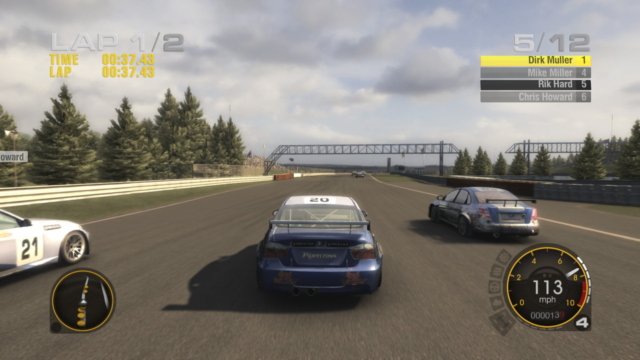
Race Driver: GRID
Written by: Rik
Date posted: May 9, 2021
- Genre: Racing
- Developed by: Codemasters
- Published by: Codemasters
- Year released: 2008
- Our score: 6
The TOCA Race Driver games of the first half of the 00s were an evolution of the fairly basic structure of two previous TOCA titles that were based firmly on the British Touring Car Championship. With the change of name came a change of emphasis, from simply becoming the BTCC champion to building a career as the titular race driver, bringing a wider variety of vehicle types and circuits into the mix.
A supporting storyline was another element to be introduced, with the initial TOCA Race Driver basing the action around a named protagonist, Ryan McKane, before he was shunted aside for the sequel, which retained the cut-scenes, but put you at the centre of the action, with the video sequences showing your character receiving the advice of a pit crew chief and manager (among others) now shown from a first-person perspective.
Both games were solid and entertaining racers, although they were rather similar to each other, and in both cases contained rather more circuit-based racing than your correspondent could stomach in one sitting. With that in mind, TOCA Race Driver 3 has been skipped for now, with a glance at the box suggesting that a similar (and hefty) feast lay in store, and so we move onto a further reworking of the brand, in both name and style, with TOCA dropped from the title altogether.
So now we have a game called GRID, although the Race Driver part of the name has been retained for this one, and that’s still what the action is all about. Your crew chief and manager both remain present, too, although they’re now in unseen roles, advising you by voice only. Both can now refer to you by name, as long as that name exists in the list of presets: if it doesn’t, or you find the whole concept too ludicrous to take seriously, you can opt for an arrogant nickname, like Ace, instead.
The world of GRID is a step away from the primary colours motorsport of previous titles, and with the series’ move to the Xbox 360/PS3 generation of consoles comes a foot firmly placed in the street racing camp, and the introduction of a new visual style of muted colours and excessive smoke effects. There’s no doubting that it’s all very well done and draws a clear line in the sand between the TOCA and GRID eras, although with the benefit of hindsight perhaps the palette has been faded out a little too much.
Despite the overhaul in terms of presentation, though, the structure remains similar, with a variety of disciplines and vehicles to try out. The action is divided into three territories, two of which – America and Japan are broadly more street-based – with the European leg focusing on more on traditional motor racing circuits.
Although some of the racing has now moved onto the streets, there’s no talk of ‘respect’ here. You do, however, have to earn reputation points [ah, that’s completely different – FFG reader] in order to progress. After an initial trial period, taking on contracts for other teams, you eventually earn enough reputation and money to buy your first car of your own and set up your own team. Options are limited at first but as you build up reputation, and crucially, earn money, you can choose your territory and enter different tournaments as you please, as long as you have, or can afford, the car required. The first tier of tournaments start with only two races but by the final tier you have to string good performances together across five events.
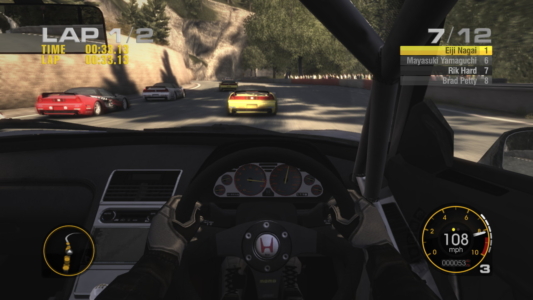
The cockpit view features realistic dashboards, which you know I like. But in this case not enough to actually use this view.
Success also brings you sponsorship offers, which earn you additional money with each race, although some are performance based and require you to achieve a certain position. You have a slot for one major sponsor, who will pay out double, so it’s worth making a shrewd selection here. And if you somehow forget to review the list of new sponsors, you will get a reminder from your manager, incredulous that you might want to proceed without doing so.
You can also continue to drive for other teams to earn money, but it seems rather redundant, as you don’t earn as many reputation points. The one exception is the recurring, season-ending, 24 hour (read: 12 minute) race at Le Mans, which can be a good earner at the start, but can be skipped later if you hate it (as I did). I’m not really sure of the relevance of things being divided into seasons – they’re fairly short and the passing of each one seems largely meaningless, and there’s no maximum as far as I can tell – other than artificially breaking things up and showing a summary of current your driver and team ranking.
The majority of the race types are variations on ‘a small number of laps around circuits’. As before, and as with other similar games, there’s no qualifying, and determination of your grid position (despite the name of the game) seems to be made at random. Under such circumstances, some rather assertive manoeuvring at the outset is required, although damage modelling is impressively comprehensive, and so collisions don’t come without risk.
The AI drivers also crash into each other and spin out themselves, which technically does you a favour, although not if they don’t get out of the way, or their snafu creates a large plume of smoke that obscures your vision. In theory, keeping you informed of events on the track is part of your chief’s role, which is otherwise to offer general encouragement and occasionally call you ‘kid’, and he does indeed provide you with regular updates about accidents and who is involved. Unfortunately, this usually takes place immediately in front of you, and you’ve therefore just witnessed what he’s telling you about with your own eyes.
More useful is GRID’s signature innovation, known as Flashback. This allows you to access, at any point, an instant replay of the last few seconds, rewind the action and start again from that point, thus allowing you to remedy any serious driving errors. Depending on your difficulty level, these are limited to a certain number per race, and can even be turned off altogether, although as mentioned, you’ll need to avoid things that aren’t your fault as well as those that are, and personally I’d have found the game impossible to progress through without it.
I guess it does beat having to endlessly restart races from the beginning, but at the same time, it does feel a bit weird to have failure baked into the game, and it can make you wonder if making use of the feature is somehow preventing you from improving. It can also take you out of the rhythm of a particular lap, and occasionally you can burn through a few Flashbacks by repeating the same mistake, or making brand new ones at the same point in the race.
An analogue pad of some description is a must, as careful control of the throttle and brakes is required to avoid spinning and locking respectively. There doesn’t seem to be a massive amount of difference in handling between cars, and in contrast to earlier Race Driver games, there’s certainly no novelty truck racing or anything like that. However, there are some unusual events, such as a demolition derby, and touge, which is a downhill duel as seen in NFS Carbon. Meanwhile, drift events have also been introduced, and although the implementation is slightly more refined than in other arcade racers of similar vintage, it’s largely the same tale of uncontrollable wheelspinning that’s possible to fluke about 20% of the time, sufficient to hop over the low bar for success.
The introduction of these street-racing elements into the mix calls to mind Need for Speed, although GRID came out at a time when the series was in the process of moving in the other direction. (It actually most closely reminded me of Juiced, another echo of the mid-00s). On the other hand, there is still a strong Touring Car element, but the European races are arguably the most challenging and least enjoyable bits of the game. It’s hard to put a finger on why: ‘on the track’ is where this series’ roots lie, but the skills that serve you well in street races don’t seem to translate to the more traditional circuit races.
And GRID is a grind. It was by this time the established style, of course, but after a certain point you do start to wonder about how much more time you want to invest. Money and reputation cease to be a problem about 60% of the way through, but the career mode struggles to pick up any momentum. You can recruit a team-mate, to improve your team’s reputation and income, but even this starts to lose its importance once money isn’t an issue, at which point your colleague simply becomes an on-track irritant.
Regardless of who you choose, they end up giving you constant and largely pointless updates which verge on the comedic, with one of mine seemingly obsessed with ‘yoo-hoo! Can you see me?’ type updates, as if we were both driving in convoy to the south of France for a holiday. If your team-mate is no good, then he adds nothing to races other than the dubious pleasure of hearing his continuous lamentations about having messed things up, and if he is, then he could end up beating you to the finish line. Plus weighing up various signing fees, specialisms and the largely unfathomable skill-based pie chart is something you can do without spending time on.
GRID is certainly technically sound, and there are plenty of enjoyable moments sprinkled across the substantial career, albeit a little too lightly. Need for Speed: SHIFT suffered similar bloating, but managed to pick up the pace with the career finale in sight and an exhilarating last tournament. Here, though, the mind starts to wander. As things get more challenging you wonder whether you’ve actually got any better at the game for all the time invested, and the final races start to look more like a chore than something to strive for.
And the driving itself seems to lack thrills. I ended up focusing on, and becoming irritated by, the randomness of the grid positions, and the element of luck involved in negotiating the collisions and jostling for position in the early parts of races. Both of which are part and parcel of the genre, but perhaps better games are able to hide it more easily. By happy coincidence, I had actually been spending some time with a console contemporary, Project Gotham Racing 4, in recent months, and while some reviews at the time suggested GRID was a strong contender for PGR’s arcade racing crown, to me this seems a long way away from Bizarre’s effort.
For site anniversary reasons, playing GRID overlapped with going back to the original TOCA Touring Car Championship. Despite the massive changes and improvements made over the years, the comparatively rudimentary championship mode of that dusty relic retained a certain focus lacking in the career mode here. Perhaps, in retrospect, I was too generous to the previous Race Driver games. Or maybe I’ve been playing rather too many of these track-based racers recently. But as things stand, I can only put GRID in the middling-to-enjoyable category.

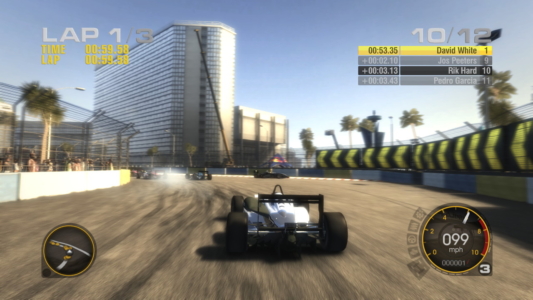
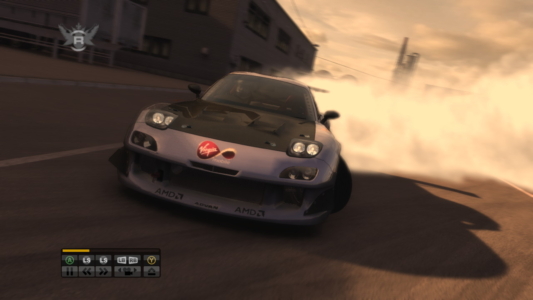
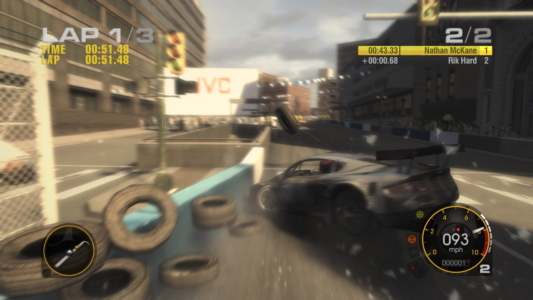

 Posts
Posts
“Flashback” might not be a GRID innovation, for this feature, also dubbed as “unique”, existed in “SCAR Squadra Corse Alfa Romeo” racing game, but with a flashier name : the “Tiger Effect”. It somewhat compensated for game’s difficulty due to poor joystick handling and/or cheating A.I. (don’t know for sure, just a feeling I had when I tried the game a few years ago). The other “feature” was an RPG-like design. Game deserved a D. Milestone’s milestone was Screamer and Screamer 2, it seems.
https://en.wikipedia.org/wiki/Alfa_Romeo_Racing_Italiano
May 9, 2021 @ 10:49 pm
Certainly Codemasters claimed it as their innovation. I couldn’t quite shake the vague feeling that GRID wasn’t the first game I’d played to use such a system, but never quite pinned anything down.
It wasn’t SCAR though – never played that one!
May 11, 2021 @ 5:18 pm
Chronology talks : SCAR is dated 2005 while Grid is dated 2008. I can’t remember any other racing game providing this feature of dubious value — and I’ve seen *a lot*.
You’re lucky, then ! 😉 I guess you’d grade it 4 at best, and this would be deserved.
Now, go back to Mass Effect 3, please : your regular readers are waiting for your final review. 😉
May 11, 2021 @ 9:17 pm